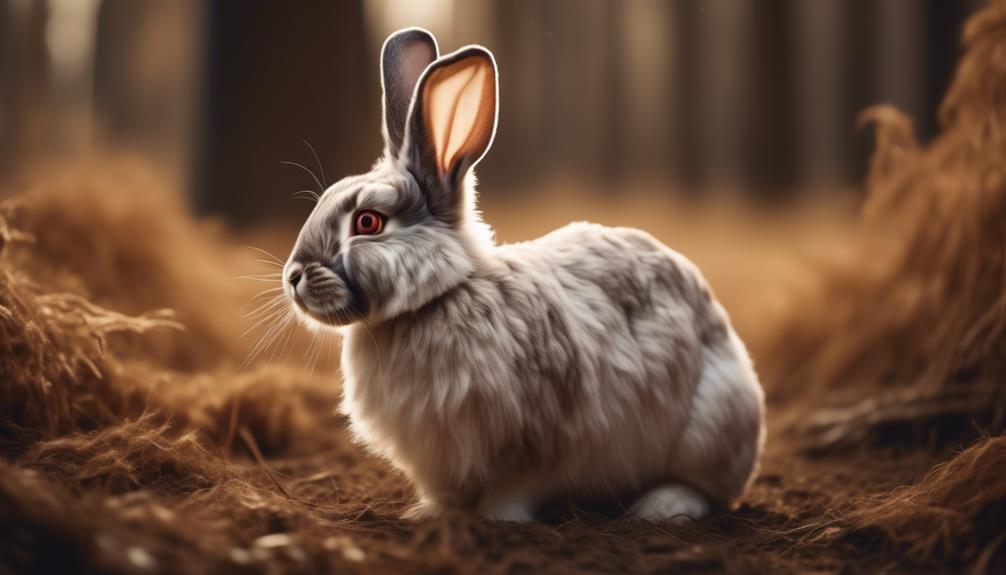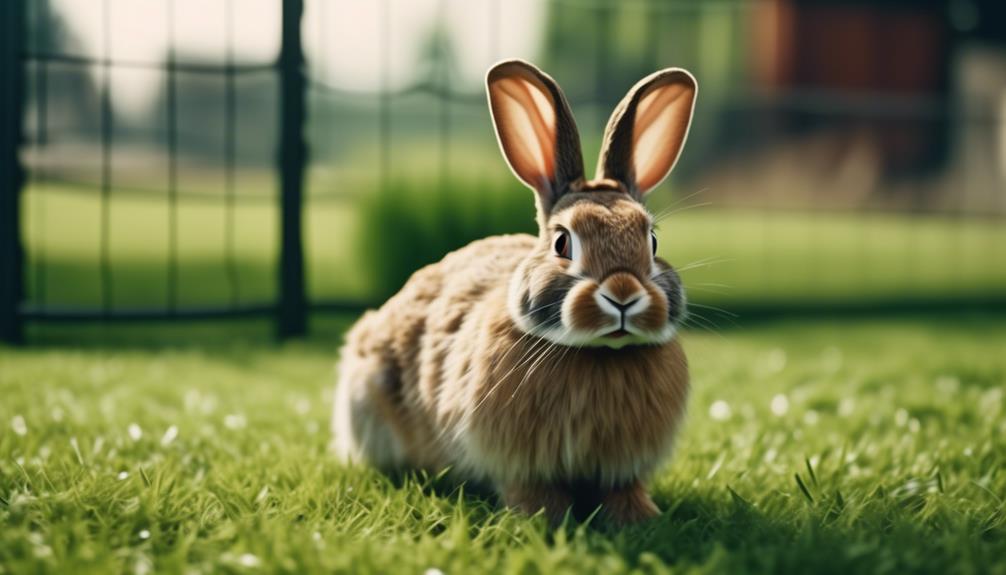
Step back in time and journey into the captivating world of Beveren rabbits, where history intertwines with beauty and charm.
These remarkable creatures have graced the lands of both England and Belgium, captivating the hearts of rabbit enthusiasts for centuries. With their distinctive features and coveted fur, Beveren rabbits have become a beloved breed around the globe.
But what makes them truly fascinating? Stay tuned as we uncover the secrets of their origin, explore their unique qualities, and reveal the captivating colors that set them apart.
Prepare to be enthralled by the wonder of the Beveren rabbit world.
Key Takeaways
- Beveren rabbits are a large breed, weighing between 8-12 lbs, and have a semi-arch/mandolin body shape.
- They have a dense, short, glossy, and thick coat of fur that comes in a variety of colors, with only three accepted by the ARBA.
- Beveren rabbits require a large enclosure, both indoors and outdoors, and their indoor environment needs to be rabbit-proofed.
- Their diet should consist mainly of hay, along with pellets, fruits, vegetables, and leafy greens.
Beveren Rabbit Information
The Beveren rabbit is a large breed known for its mandolin-shaped body and a weight range of 8-12 pounds. These rabbits have a lifespan of 5-10 years and are best suited for singles, families with older children, and as house rabbits. They can be kept both indoors and outdoors.
The Beveren rabbit originated in England or was named after the town of Beveran in Belgium. It became the most popular fur breed in the UK and was later exported to America. The American Rabbit Breeders Association (ARBA) accepted the Beveren rabbit and a club was founded in 1918. This breed is comparable to the English Lop and Havana Rabbit.
Overall, the Beveren rabbit has a large size, a semi-arched body shape, a full round face, and large ears that stand vertically. Their coat is dense, short, glossy, and thick. The accepted colors for this breed include solid blue, solid black, and blue-eyed white (BEW).
Proper care for Beveren rabbits includes providing a large enclosure, rabbit-proofing indoor spaces, and a diet consisting of hay, pellets, fruits, vegetables, and leafy greens.
Beveren Rabbit Breed History/Origin

After learning about the characteristics and care requirements of the Beveren rabbit, it’s important to delve into its fascinating breed history and origin.
The Beveren rabbit is believed to have originated in England or named after the town of Beveran in Belgium. It gained popularity in the UK and became the most popular fur breed. The breed was later exported to America and accepted by the American Rabbit Breeders Association (ARBA).
In 1918, the Beveren Club was founded to promote the breed’s growth. Comparable breeds to the Beveren rabbit include the English Lop and Havana rabbit.
Understanding the breed’s history and origin provides insight into its development and significance in the rabbit breeding community.
Overall Description of Beveren Rabbit

With its large size and distinctive semi-arch/mandolin shaped body, the Beveren rabbit is a captivating breed that commands attention. Weighing between 8-12 lbs, these rabbits have a full, round face and large ears that stand vertically, measuring five inches or more.
Their coat is dense, soft, and short, with a glossy and thick texture. The Beveren rabbit comes in a variety of colors, but only three colors – solid blue, solid black, and blue-eyed white (BEW) – are accepted by the American Rabbit Breeders Association (ARBA).
When it comes to care requirements, these rabbits need a large enclosure, whether indoor or outdoor, and a diet that consists mainly of hay, along with pellets, fruits, vegetables, and leafy greens.
Beveren Rabbit Colors

Beveren rabbits come in a variety of captivating colors, adding to their charm and appeal. While there are many color variations, the American Rabbit Breeders Association (ARBA) only accepts three colors for show purposes: solid blue, solid black, and blue-eyed white (BEW).
These accepted colors determine the rabbit’s classification in shows and contribute to the breed’s recognition. The solid blue and solid black colors showcase the rabbit’s glossy and dense fur, while the blue-eyed white stands out with its unique eye color.
The different colors of Beveren rabbits make them visually appealing and highlight the breed’s versatility. Whether it’s the deep blue or the striking blue-eyed white, each color adds to the overall allure of these fascinating rabbits.
Beveren Rabbit Care Requirements

The care requirements for Beveren rabbits are essential to ensure their well-being and happiness. These large rabbits require a spacious enclosure, whether it’s indoors or outdoors.
For outdoor enclosures, a wooden structure with a raised and fenced bottom is recommended to protect them from predators. Indoor enclosures should have wire frames on the sides and a plastic bottom with soft bedding. Rabbit-proofing the indoor space is crucial to eliminate potential hazards.
In terms of diet, Beveren rabbits should have a diet that consists of 70% hay, along with pellets, fruits, vegetables, and leafy greens.
Providing these care requirements will help ensure that Beveren rabbits have a healthy and fulfilling life.
Beveren Rabbit Enclosure

To provide a comfortable living space for a Beveren rabbit, a large and well-structured enclosure is essential. Here are some important considerations for creating the perfect Beveren rabbit enclosure:
- Size: The enclosure should be spacious enough for the rabbit to move around freely and stretch its legs.
- Outdoor vs. Indoor: Depending on your living situation, you can choose between an outdoor or indoor enclosure. Outdoor enclosures should have a raised and fenced bottom to protect the rabbit from predators, while indoor enclosures should have wire frames on the sides and a soft bedding on the bottom.
- Rabbit-Proofing: Make sure the enclosure is free from potential hazards such as toxic plants, sharp objects, or small spaces where the rabbit can get stuck.
- Enrichment: Provide toys, tunnels, and hiding spots to keep your Beveren rabbit mentally stimulated and entertained.
Beveren Rabbit Outdoor Enclosure

Creating a safe and secure outdoor enclosure is essential for providing a comfortable living space for a Beveren rabbit. This enclosure should be designed to protect the rabbit from predators, extreme weather conditions, and provide ample space for exercise.
To grab the attention of the audience, here is a table showcasing the important features of a Beveren rabbit outdoor enclosure:
| Feature | Description |
|---|---|
| Size | A large enclosure that allows the rabbit to hop, run, and stretch |
| Material | Sturdy wood or metal construction to withstand weather and predator attacks |
| Flooring | A raised and fenced bottom to prevent escape and protect from burrowing predators |
| Shelter | A cozy and insulated hutch or hideaway to provide shade and protection from the elements |
Beveren Rabbit Indoor Enclosure

After ensuring a safe and secure outdoor enclosure for a Beveren rabbit, attention can now be turned to providing a comfortable indoor living space. Here are some important considerations for creating an ideal indoor enclosure for a Beveren rabbit:
- Size: The indoor enclosure should be spacious enough to allow the rabbit to hop, stretch, and explore. A minimum of 8 square feet of floor space is recommended.
- Flooring: Use a wire frame on the sides of the enclosure to provide ventilation and visibility. The bottom should be made of plastic to prevent the rabbit from digging out, with a soft bedding material to provide comfort.
- Enrichment: Include toys, tunnels, and hiding spots to keep the rabbit mentally stimulated and entertained.
- Rabbit-Proofing: Ensure that the indoor space is free of potential hazards such as electrical cords, toxic plants, and small objects that the rabbit could ingest.
Beveren Rabbit Diet

A healthy diet is essential for the well-being of a Beveren rabbit. These rabbits require a balanced diet that includes a variety of foods to meet their nutritional needs.
The foundation of their diet should be high-quality hay, which should make up about 70% of their daily food intake. Hay provides essential fiber that supports their digestive system and helps prevent dental problems.
In addition to hay, Beveren rabbits should also be given a small amount of pellets that are specifically formulated for rabbits. These pellets contain essential vitamins and minerals that are necessary for their overall health.
To add variety, fresh fruits, vegetables, and leafy greens can be offered as occasional treats. It’s important to introduce new foods slowly to avoid digestive upset.
Providing clean, fresh water at all times is also crucial for their well-being.
Frequently Asked Questions
How Do Beveren Rabbits Behave Around Other Pets, Such as Cats or Dogs?
Beveren rabbits are generally sociable and can get along well with other pets, including cats and dogs. However, it’s important to introduce them slowly and supervise their interactions to ensure everyone’s safety and well-being.
Can Beveren Rabbits Be Trained to Use a Litter Box?
Yes, Beveren rabbits can be trained to use a litter box. With patience and consistency, they can learn to associate the litter box with their bathroom habits, making it easier to maintain a clean living space.
What Are Some Common Health Issues That Beveren Rabbits May Experience?
Beveren rabbits may experience common health issues such as dental problems, obesity, and gastrointestinal issues. Regular veterinary check-ups, proper diet, and exercise can help prevent and manage these health concerns.
Are Beveren Rabbits Suitable for Apartment Living?
Yes, Beveren rabbits are suitable for apartment living. They can adapt well to indoor environments as long as they have enough space to move around and receive proper care and attention.
How Often Should Beveren Rabbits Be Groomed?
Beveren rabbits should be groomed at least once a week to maintain their dense, glossy fur. Regular grooming helps prevent matting and keeps their coat in good condition.
What Are the Main Differences Between Beveren and Mini Rex Rabbits?
When comparing Beveren and Mini Rex rabbits, it’s important to note their differences. While Beveren rabbits are known for their large size and upright ears, the charming world of Mini Rex rabbits includes their small, compact size and unique coat of fur that feels like velvet to the touch.
Conclusion
In conclusion, the world of Beveren rabbits is truly fascinating. From their unique characteristics and rich history to their adorable appearance and range of accepted colors, these rabbits are truly captivating.
It’s important to provide them with suitable enclosures and a balanced diet in order to ensure their well-being. So, whether you choose to have an outdoor or indoor enclosure, be sure to give these amazing creatures the care they deserve.




